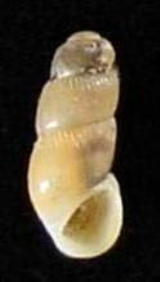
Truncatellidae
Encyclopedia
Truncatellidae, common name
the "looping snails", is a family
of small amphibious snails, with gill
s and an operculum
, semi-marine gastropod mollusks or micromollusk
s.

s which lose their apical whorls
as they grow, giving the shells a truncated and cylindrical appearance.
):
Truncatellinae
Geomelaniinae
subfamily ?
.
Common name
A common name of a taxon or organism is a name in general use within a community; it is often contrasted with the scientific name for the same organism...
the "looping snails", is a family
Family (biology)
In biological classification, family is* a taxonomic rank. Other well-known ranks are life, domain, kingdom, phylum, class, order, genus, and species, with family fitting between order and genus. As for the other well-known ranks, there is the option of an immediately lower rank, indicated by the...
of small amphibious snails, with gill
Gill
A gill is a respiratory organ found in many aquatic organisms that extracts dissolved oxygen from water, afterward excreting carbon dioxide. The gills of some species such as hermit crabs have adapted to allow respiration on land provided they are kept moist...
s and an operculum
Operculum (gastropod)
The operculum, meaning little lid, is a corneous or calcareous anatomical structure which exists in many groups of sea snails and freshwater snails, and also in a few groups of land snails...
, semi-marine gastropod mollusks or micromollusk
Micromollusk
A micromollusk is a descriptive term for a shelled mollusk which is extremely small, even at full adult size. The word is usually, but not exclusively, applied to marine mollusks, although in addition, numerous species of land snails and freshwater mollusks also reach adult size at very small...
s.

Shell description
This family of snails have small shellGastropod shell
The gastropod shell is a shell which is part of the body of a gastropod or snail, one kind of mollusc. The gastropod shell is an external skeleton or exoskeleton, which serves not only for muscle attachment, but also for protection from predators and from mechanical damage...
s which lose their apical whorls
Whorl (mollusc)
A whorl is a single, complete 360° revolution or turn in the spiral growth of a mollusc shell. A spiral configuration of the shell is found in of numerous gastropods, but it is also found in shelled cephalopods including Nautilus, Spirula and the large extinct subclass of cephalopods known as the...
as they grow, giving the shells a truncated and cylindrical appearance.
Subfamilies
The family Truncatellidae consists of two subfamilies (according to the taxonomy of the Gastropoda by Bouchet & Rocroi, 2005Taxonomy of the Gastropoda (Bouchet & Rocroi, 2005)
The taxonomy of the Gastropoda as it was revised by Philippe Bouchet and Jean-Pierre Rocroi is currently the most up-to-date overall system for classifying gastropod mollusks...
):
- subfamily Truncatellinae Gray, 1840
- subfamily Geomelaniinae Kobelt & Möllendorff, 1897
Genera
Genera within the family Truncatellidae include:Truncatellinae
- Truncatella Risso, 1826 - type genus of the family Truncatellidae
Geomelaniinae
- Geomelania L. Pfeiffer, 1845 - type genus of the subfamily Geomelaniinae
subfamily ?
- TaheitiaTaheitiaTaheitia is a genus of gastropod in the Truncatellidae family.- Species :Species within the genus Taheitia include:* Taheitia alata* Taheitia elongata * Taheitia filicosta...
Adams, 1863
Habitat
Snails in this family are found in marine coastal environments, near or just above the high tide line on stones and pebbles, fine sediments and decomposing vegetation.Life cycle
The sexes are separate. Fertilized eggs are laid as egg capsules, which are attached to detritusDetritus
Detritus is a biological term used to describe dead or waste organic material.Detritus may also refer to:* Detritus , a geological term used to describe the particles of rock produced by weathering...
.

